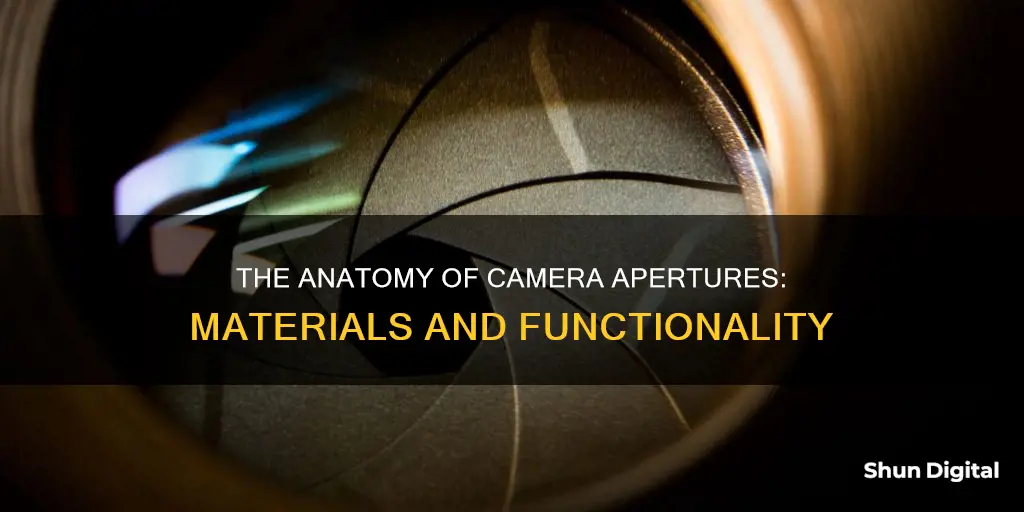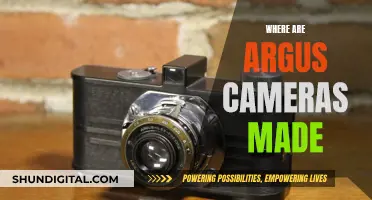
A camera aperture is the opening in a lens through which light passes. The aperture is made up of an array of aperture blades in the lens that move synchronously to adjust the size of the opening. The aperture blades contribute to the bokeh – the aesthetic quality of the out-of-focus areas in an image.
| Characteristics | Values |
|---|---|
| Purpose | To control the amount of light entering the camera |
| Mechanism | An array of aperture blades in the lens that move synchronously to adjust the size of the aperture |
| Aperture Blades | Contribute to the bokeh (aesthetic quality of the out-of-focus areas in an image) |
| Number of Blades | Typically, lenses with a greater number of blades render rounder and more pleasing bokeh |
| Aperture vs F-Stop | F-stop is not the actual size of the aperture but has an inverse relationship to it |
| Aperture and Exposure | A large aperture results in a brighter photograph, while a small aperture does the opposite |
| Aperture and Depth of Field | A large aperture creates a shallow depth of field, while a small aperture gives you a wide depth of field |
| Aperture and Shutter Speed | A large aperture requires a faster shutter speed to achieve the correct exposure |
| Aperture and ISO | A large aperture requires a lower ISO to achieve the correct exposure |
What You'll Learn
- Aperture is the opening in a lens through which light passes to enter the camera
- Aperture is measured in f-stops
- Aperture controls the depth of field in your photograph
- Aperture is one of the three pillars of photography, along with shutter speed and ISO
- Aperture priority mode allows the user to select the aperture while the camera sets an appropriate shutter speed

Aperture is the opening in a lens through which light passes to enter the camera
The aperture of a lens is the opening through which light passes into the camera. The wider the opening, the more light can reach the camera sensor, affecting the exposure of the image. The aperture needs to increase or decrease to achieve the correct exposure in different lighting conditions. This is done by an array of aperture blades in the lens that move synchronously to adjust the size of the aperture.
The aperture is like the "pupil" of the camera system, opening and closing to change the amount of light that passes through. The aperture is controlled by a diaphragm, which functions like the iris of the eye, blocking any light that tries to pass except through the centre.
Aperture is expressed in f-stops, which are often written as fractions, e.g. f/1.4 or f/16. The f-number is not the actual size of the aperture but has an inverse relationship with it: aperture diameter = focal length (f) divided by the f-number. This is why lower f-numbers indicate a larger aperture, as 1/4 is bigger than 1/16. Each increment on the standard f-stop scale halves the amount of light that reaches the sensor.
Aperture also affects the depth of field in an image, which is the amount of the photograph that appears sharp from front to back. A large aperture gives a blurred background with a shallow focus effect, which is popular for portrait photography. A small aperture gives a sharper photo, which is ideal for landscape photography.
Aperture is one of the three sides of the Exposure Triangle, along with shutter speed and ISO. It is the interaction of all three that determines the exposure of an image. Aperture controls the amount of light entering through the lens, shutter speed dictates the duration of light hitting the sensor, and ISO sets the camera sensor's sensitivity to light. Mastering the Exposure Triangle means balancing all three elements while being aware of the implications of tweaking any one of them.
Sleep Mode: Does It Affect Your Privacy?
You may want to see also

Aperture is measured in f-stops
The f-stop is expressed as a fraction, with "f" as the numerator and the f-stop number as the denominator. The aperture size is inversely proportional to its corresponding f-number: a smaller f-number denotes a larger aperture, and vice versa. For example, an f-number of 2 means the focal length is twice the diameter of the entrance pupil.
The f-stop scale is an approximately geometric sequence of numbers that corresponds to the sequence of the powers of the square root of 2: f/1, f/1.4, f/2, f/2.8, and so on. Each f-stop in the sequence is one stop lower than the one to its left and one stop higher than the one to its right, representing a halving or doubling of light intensity, respectively.
The f-stop is a way to normalise the aperture setting across different lenses. It takes into account both the length of the lens and the diameter of the opening, resulting in a relative aperture. This means that the same f-stop on different lenses will allow the same amount of light to hit the sensor.
The word "stop" in photography has multiple meanings. In addition to referring to the aperture measurement, a stop can also be a physical object that blocks light rays, such as the aperture stop or field stop. In terms of exposure, a stop is a unit used to quantify ratios of light, with each added stop doubling the amount of light and each subtracted stop halving it.
Yi Lite Action Camera: How Long Does the Battery Last?
You may want to see also

Aperture controls the depth of field in your photograph
Aperture is the opening in a lens through which light passes to enter the camera. It is calibrated in f-stops, written in numbers like 1.4, 2, 2.8, 4, 5.6, 8, 11 and 16. The larger the number, the narrower the aperture. Aperture is one of the three pillars of photography, the other two being shutter speed and ISO.
A large aperture (a wide opening) will pass a lot of light, resulting in a brighter photograph. A small aperture does just the opposite, making a photo darker. A large aperture also results in a shallow depth of field, with a blurred background and beautiful shallow focus effect. Portrait photographers use this effect a lot. Landscape photographers, on the other hand, use a small aperture to ensure that both the foreground and background are as sharp as possible.
The f-stop numbers on your camera represent the size of the aperture. A small f-stop like f/16 represents a much smaller aperture opening than something like f/2.8. So, if you want a shallow depth of field, you should use a large aperture like f/1.4 or f/2.8. And if you want a wide depth of field, you should use a small aperture like f/8, f/11 or f/16.
The depth of field is also determined by the distance from the lens. The closer an object is to the lens, the shallower the DoF. Conversely, the farther away an object is, the deeper the DoF.
Simplisafe Outdoor Camera: Charging Frequency Explained
You may want to see also

Aperture is one of the three pillars of photography, along with shutter speed and ISO
Aperture, shutter speed, and ISO are the three pillars of photography. They are also known as the "Three Kings of Photography" or the "Exposure Triangle". These three elements work together to create an exposure.
Aperture
Aperture is the opening of the lens through which light passes. It is calibrated in f/stops, written in numbers like 1.4, 2, 2.8, 4, 5.6, 8, 11, and 16. The larger the number, the narrower the aperture. A large aperture lets more light in, and vice versa.
Shutter Speed
Shutter speed refers to the length of time a camera shutter is open to expose light into the camera sensor. Shutter speeds are typically measured in fractions of a second. Slow shutter speeds allow more light into the camera sensor and are used for low-light and night photography, while fast shutter speeds help to freeze motion.
ISO
ISO controls how sensitive your camera is to light. A lower ISO number represents a darker image, while higher numbers mean a brighter image. However, as the ISO rises, so does the visibility of graininess or noise in your images.
How They Work Together
When taking a picture, light passes through the lens and reaches the shutter curtain, which opens to let the light hit the camera sensor for a specified amount of time. This amount of time is the shutter speed. The sensor then gathers the light, and the ISO brightens the image if necessary.
To get the right exposure, or the correct amount of light, the aperture, shutter speed, and ISO need to work together. For example, if there is a lot of light entering the lens, a very small aperture will block some of it. In this case, the camera sensor would need more time to collect the light, so a longer shutter speed would be needed. On the other hand, if the aperture is very large, a lot of light would hit the sensor, so a much shorter shutter speed would be required to avoid overexposing the image.
Battery-Powered Wi-Fi Cameras: Night Vision Included?
You may want to see also

Aperture priority mode allows the user to select the aperture while the camera sets an appropriate shutter speed
Aperture priority mode is a semi-automatic shooting mode that allows the photographer to select a specific aperture value (f-number) while the camera autoselects a shutter speed to match for a proper exposure based on the available light. This is different from manual mode, where the user must decide on both values, and shutter priority mode, where the photographer sets the speed and the camera chooses the aperture.
Aperture priority is a very useful mode as it gives you full control over what many consider the most important setting in photography. It is also faster to use than manual mode, which can take more time to set up when lighting conditions are changing.
In aperture priority mode, the camera will never change the aperture you select, so it is important to pick the right one for your desired depth of field. The aperture you choose will also alter the exposure of your images by making them brighter or darker.
A large aperture (a wide opening with a low f-number) will pass a lot of light, resulting in a brighter photograph. A small aperture (a narrow opening with a high f-number) does the opposite, making a photo darker.
Aperture priority mode is often used to allow the photographer to control the focus of objects in the frame. It is useful in landscape photography, where you may want objects in the foreground, middle distance, and background to all be in focus. To achieve this, a narrow aperture is necessary. Conversely, in portrait photography, you may want a shallow depth of field to blur the background and make it less distracting. This is achieved using a wide aperture.
Charging the Nokia Camera: A Quick Guide
You may want to see also
Frequently asked questions
A camera aperture is made of an array of aperture blades in the lens that move synchronously to adjust the size of the opening through which light passes into the camera.
Aperture blades are usually made of metal or plastic.
The wider the opening, the more light can reach the camera sensor.







